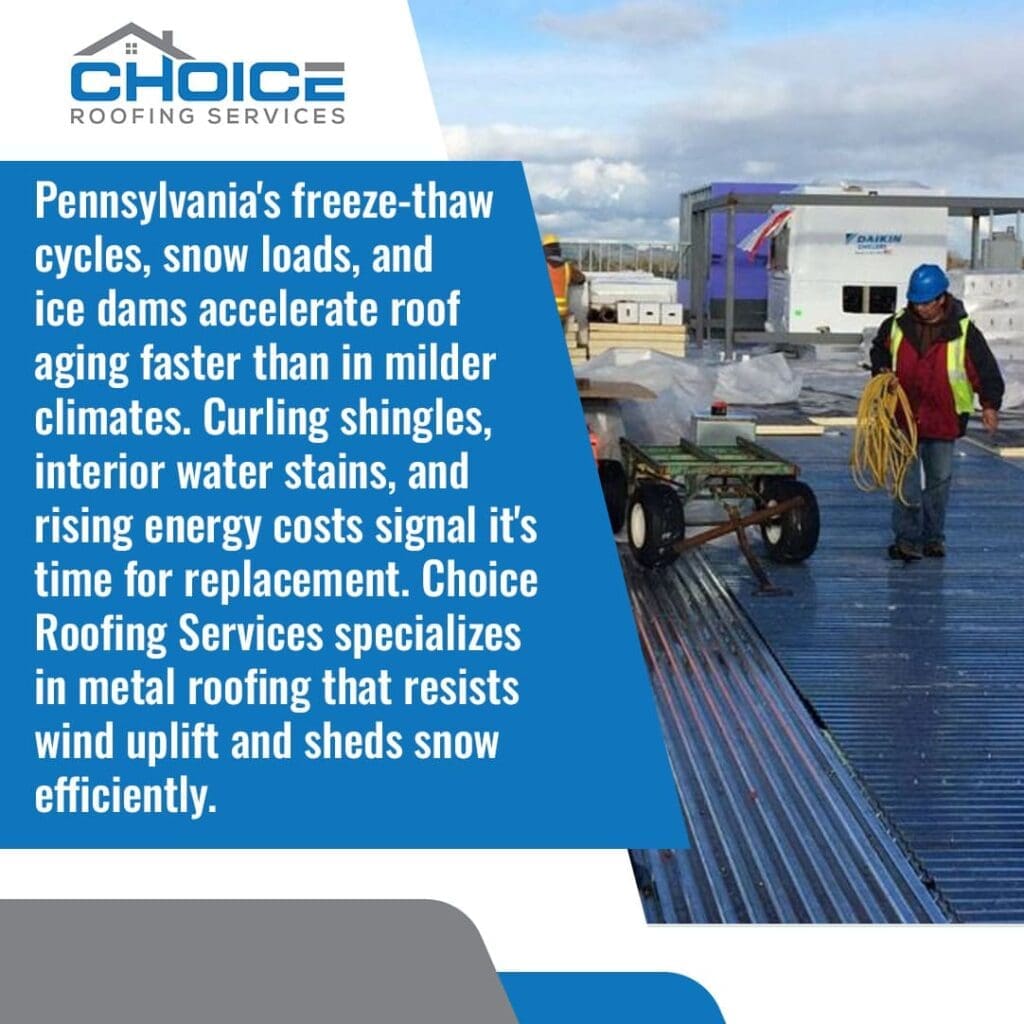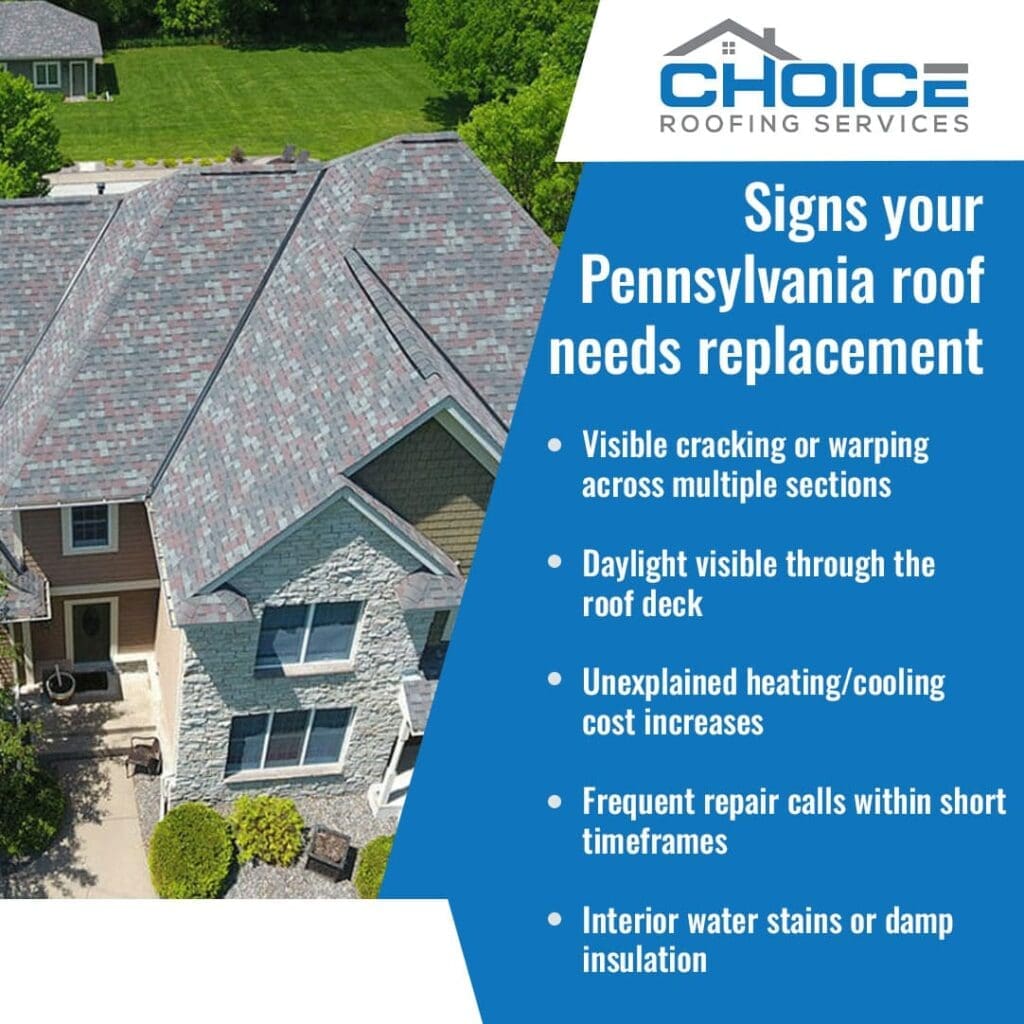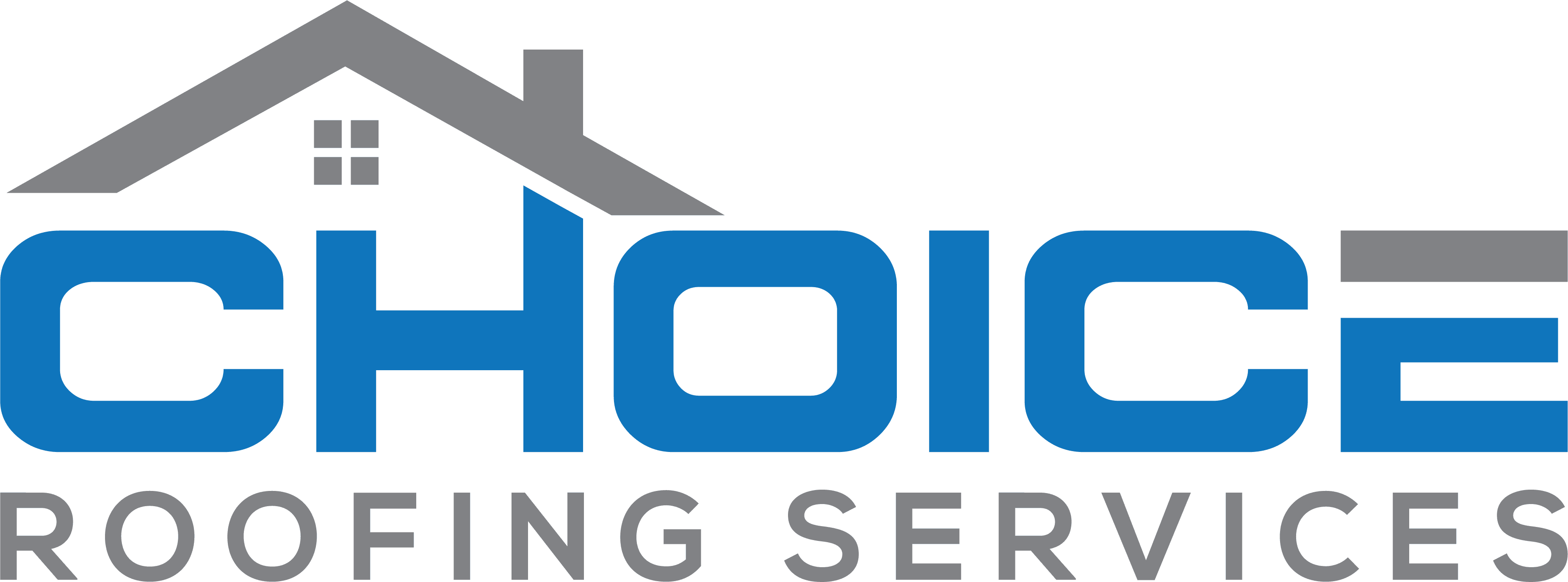Pennsylvania’s distinctive four-season climate creates demanding conditions for residential and commercial roofing systems. Homeowners throughout Bedford and the surrounding areas of Johnstown, Altoona, and Somerset face unique weather challenges that accelerate roof deterioration and complicate maintenance planning.
Understanding how regional climate affects your roof helps you recognize early warning signs, plan for roof repair or replacement decisions, and select materials that withstand local conditions. Pennsylvania’s weather extremes require homeowners to work with experienced roofing contractors near you who understand these specific challenges and can recommend appropriate solutions for long-term property protection.
Choice Roofing Services, LLC, has served southern Pennsylvania for over 18 years, specializing in metal roofing installations that withstand the region’s demanding weather patterns. Our experience with local climate conditions and commitment to quality craftsmanship help property owners make informed decisions about roofing materials, maintenance schedules, and replacement timing that protect their investments.
Pennsylvania Climate Impact on Roof Durability
Freeze-Thaw Cycle Damage
Freeze-thaw cycles cause the most destructive aging pattern for Pennsylvania roofing systems. Water penetrates small gaps during warmer periods, then expands when temperatures drop below freezing. This expansion forces cracks wider with each cycle, progressively weakening shingles and underlayment.
Pennsylvania experiences frequent freeze-thaw cycles throughout the winter months, with some areas seeing 40-60 or more cycles annually, depending on elevation and location. Each cycle stresses roofing materials through expansion and contraction, reducing their protective capabilities over time.
Heavy Snow Loads
Snow accumulation adds substantial weight to roof structures. A foot of wet snow weighs approximately 12-20 pounds per square foot. Roofs designed for standard loads can experience stress when snow depth exceeds 18 inches.
Ice Dam Formation
Ice dams form when heat escaping through the roof melts snow. The melted water flows to colder eaves where it refreezes, creating barriers that trap additional meltwater. This trapped water backs up under shingles, causing leaks and interior damage that often go unnoticed until significant harm occurs.
Summer Humidity Effects
Summer humidity levels in Pennsylvania average 60-70%, creating conditions where biological growth thrives on roof surfaces. Algae and moss retain moisture against shingles, accelerating granule loss and reducing reflective properties that protect asphalt from UV degradation.
Severe Storm Damage
Severe thunderstorms produce wind gusts exceeding 60 mph during the spring and summer months. Pennsylvania regularly experiences severe thunderstorms that bring heavy rain, strong winds, hail, and sometimes tornadoes. These storms contribute to the state’s weather hazards and impact infrastructure and safety throughout the year. These winds lift weakened shingle tabs and break adhesive seals on aging roofs.
Temperature fluctuations between seasons cause expansion and contraction in roofing materials. Asphalt shingles lose flexibility over time, making thermal movement more damaging to aged installations compared to newer roofs that maintain better elasticity.

Recognizing Replacement Indicators in Aging Roofs
Curling shingle edges, missing granules, cracked surfaces, and interior water stains indicate roof replacement needs rather than simple repairs. These symptoms appear when roofs approach 15-20 years of age in Pennsylvania’s climate.
Visible Shingle Deterioration
Shingle curling occurs when asphalt bases dry out and lose flexibility. Edges curl upward or downward, creating gaps where wind-driven rain penetrates. Curling affects multiple roof areas simultaneously on aging systems.
Granule loss appears as bare spots on shingle surfaces. These ceramic-coated granules protect underlying asphalt from UV radiation and provide fire resistance. Granules accumulate in gutters and downspouts as shingles age, with loss exceeding 30% of surface coverage indicating replacement timing.
Cracked shingles become prevalent after 15-20 years in Pennsylvania conditions. Brittleness from freeze-thaw exposure causes shingles to snap when walked upon or during thermal expansion. Multiple cracks across different roof sections suggest systemic aging.
Blistering creates raised bumps on shingle surfaces from trapped moisture or manufacturing defects. Blisters eventually rupture, exposing the underlayment to the weather. Widespread blistering across roof areas indicates material failure.
Water Intrusion Symptoms
Interior ceiling stains signal active leaks requiring immediate attention from roofing contractors. Brown or yellow discoloration appears after heavy precipitation or snow melt. Stains expand over time as water damage progresses through insulation and drywall.
Attic moisture shows as water marks on rafters or roof decking. Inspecting attic spaces after storms reveals leak locations before interior damage becomes visible in living areas.
Sagging roof sections indicate structural compromise from prolonged water exposure. Decking absorbs moisture and loses rigidity, creating visible depressions. Any sagging requires professional structural assessment beyond standard roof replacement.
Daylight visible through the roof boards from attic spaces reveals severe deterioration. These gaps allow water, insects, and outdoor temperatures to affect interior environments.
Performance Degradation Signs
Energy bills increase when aging roofs lose insulation effectiveness. Gaps in underlayment or compromised seals allow heated or cooled air to escape. Monthly utility expenses rise as roof performance declines.
Frequent repair requirements suggest systemic failure. Multiple service calls within a single year for different leak locations indicate widespread deterioration rather than isolated problems. Accumulated repair expenses over 2-3 years often make roof replacement more economical.
Seasonal Timing for Roof Replacement
Late spring through early fall provides favorable installation conditions with temperatures between 45-85°F and reduced precipitation probability. Timing affects both installation quality and project scheduling when working with roofing contractors in your area.
Weather Window Considerations
Spring installations between April and June offer moderate temperatures and manageable contractor schedules. However, Pennsylvania spring weather brings frequent rain events requiring flexible project timing.
Summer represents the peak replacement season with the longest daylight hours and the most stable weather patterns. Roofing contractors near you may have busy schedules during July and August. Extreme heat above 90°F can soften asphalt shingles during installation, creating indentation risks.
Fall scheduling from September through November provides excellent installation conditions before winter. Temperatures remain moderate while precipitation decreases compared to spring months. Completing roof replacement projects before the snow season prevents winter damage to aging roofs while allowing time for quality installation.
Winter installations remain possible during warming periods but present challenges. Asphalt shingle adhesive strips require 40°F minimum temperatures for proper bonding. Metal roofing installations proceed successfully in cold weather without temperature-dependent adhesives.
Contractor Availability Patterns
Peak season demand extends project lead times. Quality roof replacement contractors maintain full schedules 6-10 weeks ahead during the summer months. Early scheduling provides better installation date selection.
Storm damage events create sudden demand spikes that overwhelm local roofing contractor capacity. Major hailstorms or severe wind events across Pennsylvania can delay normal projects for 3-6 months following widespread damage.
Shoulder season scheduling during early spring or fall sometimes offers faster project starts. Roof replacement contractors maintain steadier workflows during these periods compared to peak summer demand.
Maintenance Practices That Extend Roof Lifespan
Annual professional inspections combined with bi-annual gutter cleaning can extend roof lifespans by 3-5 years through early problem detection. Preventive maintenance addresses minor issues before major failures develop that require complete roof replacement.
Regular Inspection Protocols
Professional roof inspections identify developing problems before significant damage occurs. Qualified inspectors examine flashing condition, shingle attachment, and underlayment integrity from both exterior and attic perspectives. Early detection prevents water infiltration and structural deterioration.
Post-storm assessments detect damage immediately after severe weather events. Wind-lifted shingles or impact damage require prompt repair to prevent water infiltration during subsequent precipitation.
Attic inspections reveal moisture issues invisible from exterior views. Water stains on rafters, mold growth, or inadequate ventilation indicate problems requiring correction before roof damage becomes severe.
Cleaning and Debris Management
Gutter cleaning twice annually prevents water overflow that damages fascia boards and roof edges. Clogged gutters cause water to back up under shingles along eaves, creating rot and leak potential. Spring and fall cleaning removes accumulated debris from Pennsylvania’s deciduous trees.
Roof surface debris removal prevents moisture retention against shingles. Leaves, branches, and organic material trap water and promote biological growth. Regular removal maintains proper drainage and reduces premature aging.
Algae treatment inhibits growth on roof surfaces. Biological growth reduces shingle reflectivity and accelerates granule loss. Treatment extends aesthetic appearance and material lifespan.
Proactive Repair Approaches
Individual shingle replacement addresses isolated damage before surrounding areas deteriorate. Replacing 5-10 damaged shingles prevents water penetration that requires extensive interior repairs.
Flashing maintenance around chimneys, vents, and roof transitions prevents most residential roof leaks. Periodic caulking and seal inspection requires minimal effort while avoiding water damage that develops from compromised flashing.
Ventilation improvements combat heat and moisture buildup that accelerates material aging. Adding soffit vents or upgrading ridge ventilation can extend roof lifespan by years through improved climate control.

Professional Assessment and Installation Quality
Experienced roofing contractors near you provide thorough damage assessments, material recommendations suited to local conditions, and installations that maximize weather resistance. Professional expertise affects long-term roof performance more than material selection alone.
Contractor Selection Criteria
Pennsylvania requires roofing contractors to maintain proper licensing and insurance. Licensed professionals demonstrate technical knowledge and comply with state regulations protecting homeowners from liability during installation projects.
Metal roofing specialization requires specific training beyond general roofing experience. Thermal expansion considerations, panel alignment techniques, and fastener selection differ substantially from asphalt shingle methods. Contractors with metal roofing expertise handle these requirements properly.
Local experience matters for understanding regional weather patterns and building code requirements. Roofing contractors familiar with the local conditions select appropriate materials and installation techniques for climate stressors.
Installation Quality Factors
Proper underlayment application creates secondary weather barriers beneath primary roofing materials. Self-adhering products around roof penetrations and eaves prevent water infiltration even when primary materials fail.
Flashing installation quality determines leak resistance around chimneys, valleys, and wall intersections. Custom-fabricated flashing provides better weather sealing than generic products. Proper overlap sequences and sealant application prevent water entry at vulnerable transitions.
Ventilation system integration during installation provides adequate airflow for temperature and moisture control. Balanced intake and exhaust ventilation maintains attic conditions that preserve roof materials.
How Choice Roofing Services Addresses Pennsylvania Weather Challenges
Metal roofing installations require specialized knowledge of thermal expansion and contraction. As experienced roof replacement contractors, our team accounts for Pennsylvania’s temperature swings by incorporating proper expansion joints and fastener spacing that accommodate seasonal movement without compromising weather seals.
Standing seam metal roofing systems eliminate exposed fasteners that create vulnerability during freeze-thaw cycles. Self-adhering ice and water barriers around roof penetrations, eaves, and valleys provide critical protection against ice dam formation and wind-driven rain.
Storm and Snow Protection
Our metal roofing installations feature smooth panel surfaces that shed snow efficiently, reducing structural stress and preventing ice dam formation. Proper attic ventilation integration maintains consistent roof temperatures that eliminate conditions causing ice dams.
Wind resistance capabilities reaching 140 mph protect homes during severe thunderstorms. Quality flashing installation around chimneys, vents, and roof transitions prevents leak points where storm damage most frequently occurs.
Local Climate Expertise
Bedford, Johnstown, Altoona, and Somerset experience distinct microclimate variations affecting roof performance. As local roof replacement contractors, our familiarity with elevation changes, precipitation patterns, and temperature extremes across these communities informs material selection and installation approaches for each project.
Addressing Weather Damage with Professional Roofing Solutions
Pennsylvania’s demanding climate requires informed decisions about roof maintenance, material selection, and replacement timing. Freeze-thaw cycles, heavy precipitation, and temperature extremes accelerate aging beyond typical expectations for roofing systems.
Choice Roofing Services has provided metal roofing solutions throughout Bedford, Johnstown, Altoona, and Somerset for over 18 years. Our focus on quality installation and attention to detail produces roofing systems that withstand regional weather challenges while providing decades of reliable protection. Contact Choice Roofing Services at (814) 410-1409 or email daniel.choiceroofing@gmail.com for a professional roof assessment. Our experience with Pennsylvania weather patterns and commitment to quality craftsmanship provide the dependable protection your property requires.

